You'll find the most effective earth pit storage solutions use seven distinct soil types, each offering unique benefits. Clay-rich traditional soil provides excellent water retention and natural sealing properties, while loamy soil delivers ideal stability with its balanced composition. Humus-enhanced mixtures boost nutrient retention and microbial activity, and silt-based compositions offer moderate drainage control. Modified sandy clay combinations prevent excessive compaction, charcoal-enriched compounds improve moisture management, and salt-enhanced clay foundations increase structural integrity. Understanding these soil types' specific characteristics will help you create the perfect storage environment for your needs.
Clay-Rich Traditional Storage Soil
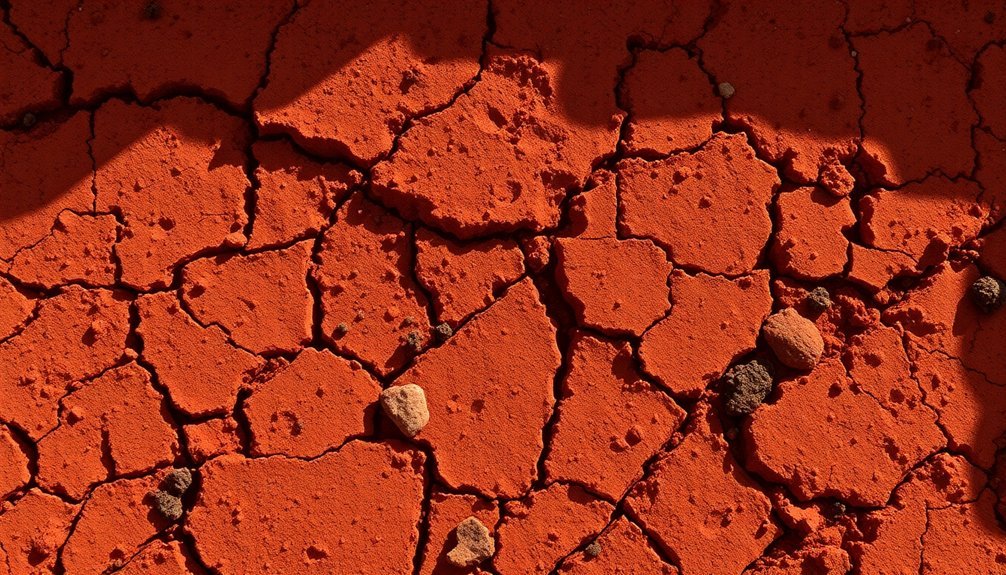
Clay-rich soil stands out among the most effective materials for earth pit storage, thanks to its unique physical properties and exceptional water retention capabilities.
You'll find that clay particles, being less than two microns in size, pack together densely to create a nearly impermeable barrier that's perfect for storage applications.
When you're constructing an earth pit, you'll need to guarantee your soil meets specific classifications (CH, CL, GC, or SC) under the Unified Soil Classification System.
Before construction begins, you'll want to remove all organic matter, trees, and grass from the site. It's vital to excavate any rocks, sand lenses, or gravel that could compromise the pit's integrity.
You'll appreciate clay's natural cohesiveness, which allows for stable embankment construction and excellent sealing properties.
This characteristic not only prevents leakage but also provides long-term durability.
While clay-rich soil isn't ideal for plant growth, it's this same quality that makes it perfect for storage purposes. The soil's tightly packed particles make it extremely difficult for air and moisture to penetrate, creating an effective seal.
Loamy Soil With Mineral Content
While clay soils excel in water retention and sealing, loamy soil offers a different set of advantages for earth pit storage through its balanced mineral composition. You'll find that loamy soil's unique blend of approximately 40% sand, 40% silt, and 20% clay creates an exemplary structure that combines stability with moderate drainage capabilities. Traditional rammed earth techniques have proven the durability of loamy soil in construction applications.
In earth pit storage applications, you can rely on loamy soil's bearing capacity of 80 to 270 kN/m², which provides substantial structural support for your storage needs. The soil's balanced particle distribution allows for controlled moisture management – it retains enough water to maintain stability while preventing waterlogging that could compromise your stored goods.
You'll benefit from loamy soil's natural resistance to compaction, which helps maintain the pit's structural integrity over time. The soil's moderate porosity guarantees proper air circulation, reducing the risk of moisture-related damage to stored items.
When you're constructing your storage pit, you'll find that loamy soil is easier to work with than clay-heavy alternatives. To maintain peak performance, you can enhance the soil's properties by adding products rich in soil microbes, guaranteeing long-term storage success.
Humus-Enhanced Earth Mixtures
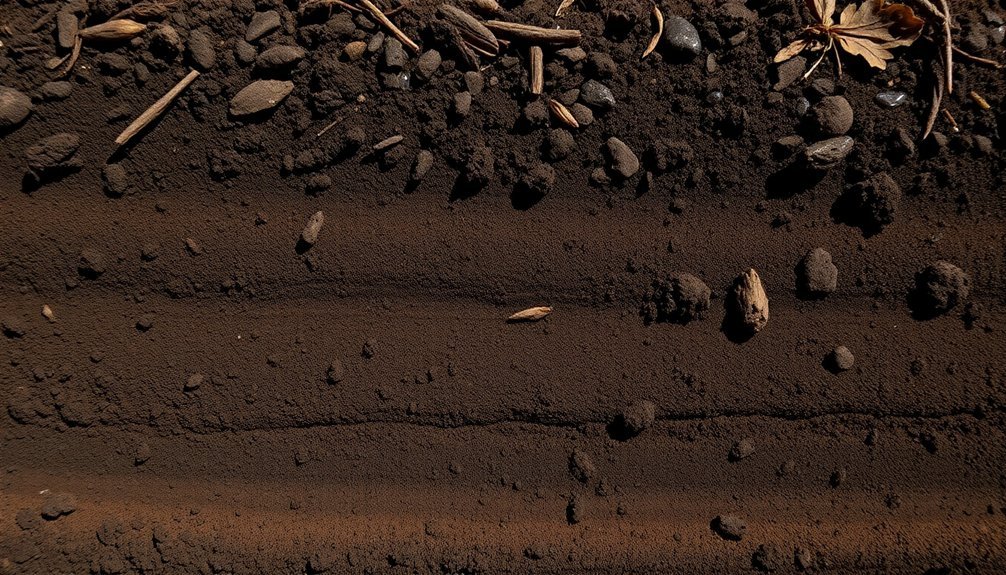
Incorporating humus into your earth pit storage mixture transforms ordinary soil into a dynamic, biologically active foundation. You'll find that humus enhances soil structure while improving water retention and nutrient availability. The high carbon content, typically around 60%, creates an ideal environment for beneficial microorganisms.
When you're adding humus to your pit storage, you'll benefit from its unique composition of humic and fulvic acids, which actively reduce soil toxicity and enhance nutrient uptake. The aging process of humus increases its effectiveness, and you'll notice better results with darker, more decomposed material. The addition of humic substances can lead to higher crop yields in storage environments that also support growing plants.
| Humus Component | Primary Function | Storage Benefit |
|---|---|---|
| Humic Acids | Nutrient binding | Enhanced preservation |
| Fulvic Acids | Metal chelation | Toxicity reduction |
| Humin | Structure building | Stability improvement |
You'll want to maintain proper moisture levels, as humic substances work best when dissolved. The addition of humus improves fertilizer efficiency and supports robust root development in your storage environment. Remember that humus works most effectively at near-neutral pH levels, where it can maximize its cation exchange capacity and nutrient retention properties.
Silt-Based Ground Composition
You'll find silt's moderate water retention capacity strikes an ideal balance between sandy and clay soils, making it an excellent choice for earth pit storage.
The fertility advantages of silt-based ground come from its ability to hold more nutrients than sandy soils while maintaining better drainage than clay, supporting the long-term preservation of stored items.
When it comes to drainage performance, you can expect silt to effectively manage moisture levels, though you'll need to monitor compaction to maintain its natural water movement properties.
Water Retention Properties
For successful earth pit storage, understanding silt soil's water retention properties is essential. You'll find that silt's fine particles create a larger surface area than sandy soils, allowing it to hold more water effectively. This balanced moisture retention makes it a viable option for storage pits, though you'll need to monitor it carefully to prevent waterlogging.
To optimize your storage pit's performance, you'll want to assess and possibly modify the soil's composition. Here's a practical breakdown of silt soil's water retention characteristics:
| Property | Impact | Management Solution |
|---|---|---|
| Water Holding | Moderate to High | Add sand for better drainage |
| Drainage Rate | Medium | Install drainage systems |
| Compaction Risk | High when wet | Minimize traffic, add mulch |
| Nutrient Loss | Moderate leaching | Use slow-release fertilizers |
You'll need to implement proper drainage solutions if you notice excessive moisture retention. Consider adding coarser materials like gravel or sand to improve drainage while maintaining beneficial moisture levels. Remember that while silt's water retention properties can protect stored items from extreme drying, too much moisture can lead to storage problems.
Fertility Advantage Factors
When examining silt-based ground composition, fertility advantages stand out as a significant benefit for earth pit storage. You'll find that silty soil excels at nutrient retention, holding onto essential elements far better than sandy alternatives. This superior nutrient-holding capacity stems from its medium-sized particles, which create an ideal environment for storing agricultural products.
The soil's ability to integrate organic matter plays a vital role in its fertility advantage. You can easily incorporate amendments, which enhance the soil's particle-binding properties and contribute to its ongoing fertility improvement. This characteristic makes silty soil particularly valuable for pit storage structures that may require periodic maintenance or modifications.
You'll benefit from the soil's thriving microbial ecosystem, which actively contributes to its fertility. The balanced particle size supports diverse microorganisms that help recycle nutrients and break down organic matter, maintaining the soil's health over time. This biological activity is essential for creating a stable storage environment.
The soil's compatibility with various plant types also indicates its excellent structural stability. While it's particularly suitable for shallow-rooted plants, this characteristic translates to reliable support for pit walls and overall storage integrity.
Drainage Performance Analysis
Understanding drainage performance in silt-based ground composition reveals both advantages and limitations for earth pit storage. You'll find that silt soils offer moderate drainage capabilities, positioning them between the quick-draining sandy soils and slow-draining clay soils.
When you're evaluating silt-based ground for pit storage, you'll need to assess several key factors. The soil's structure, with its intermediate-sized pore spaces, affects how water moves through the ground.
You'll want to check for underlying clay layers that could impede drainage and test for sodium ion concentrations that might cause soil dispersion.
You can improve drainage performance in silt soils through tile drainage systems, which help control water tables and enhance salt leaching.
You'll also benefit from natural processes like earthworm activity and organic matter decomposition, which create better soil structure and drainage pathways.
Before installing an earth pit in silt-based soil, you should conduct thorough soil testing, including electrical conductivity and SAR measurements.
Regular monitoring will be essential, as drainage performance can change over time, especially in areas with sodic or saline-sodic conditions.
Modified Sandy Clay Combinations
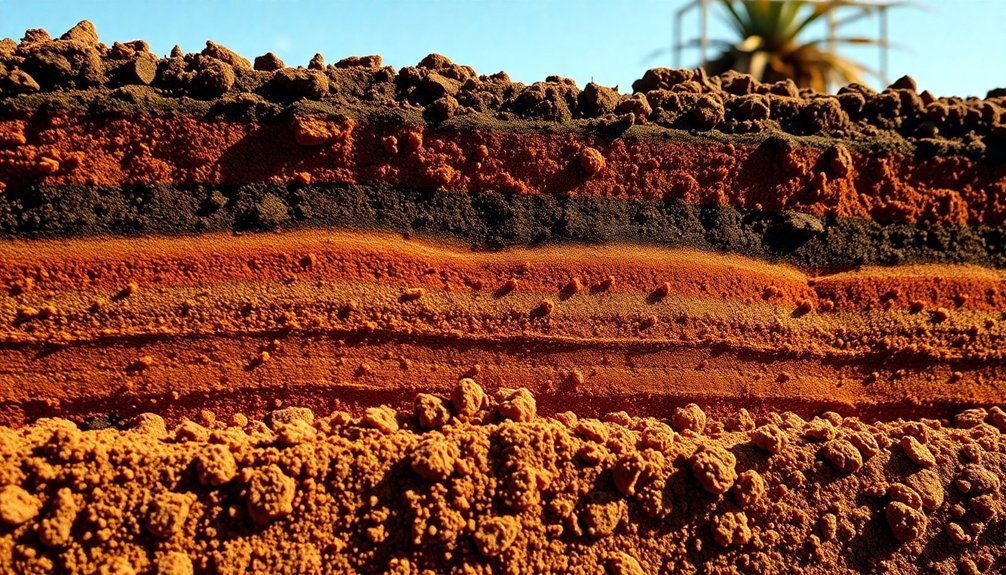
Modified sandy clay combinations represent a strategic blend of soil particles that enhance storage conditions in earth pits. You'll find that these combinations merge large sand particles (0.05-2mm) with smaller clay particles (less than 0.002mm), creating an excellent balance for storage purposes.
The addition of intermediate silt particles further enhances the soil's structural integrity.
When you're designing an earth pit storage system, this modified combination offers several key advantages:
- Maintains ideal moisture levels through balanced water retention and drainage
- Prevents nutrient leaching while ensuring consistent availability
- Resists excessive compaction, preserving structural stability
- Creates optimal conditions for long-term storage durability
You'll notice that the clay component helps retain essential moisture and nutrients, while the sand facilitates proper drainage to prevent waterlogging.
The silt particles act as a bridge between these extremes, contributing to overall soil stability. This balanced composition makes it easier for you to maintain and access your storage pit, as the soil remains workable without becoming too compact or loose.
Charcoal-Enriched Earth Compounds
When you're mixing biochar with earth compounds, you'll find significant improvements in moisture retention capabilities due to the material's highly porous structure.
Your soil mixture will benefit from biochar's exceptional water-holding capacity, which creates a more stable environment for long-term underground storage.
The addition of carbon-rich biochar also enhances the electrical conductivity of the earth compound, making it particularly useful for applications requiring consistent ground conductivity measurements.
Moisture Retention Benefits
Charcoal-enriched soil compounds offer remarkable moisture retention capabilities, acting like natural sponges in earth pit storage systems.
You'll find that biochar's porous structure creates a network of micropores that can increase water holding capacity by up to 370% in sandy soils and 11% in boreal agricultural soil. This enhanced moisture retention is particularly valuable for earth pit storage in arid or drought-prone regions.
When you're designing your earth pit storage, consider these key moisture benefits of charcoal enrichment:
- Prevents excessive water drainage through fine particle packing
- Creates long-lasting moisture retention that improves with time
- Adapts effectively to various soil types, from sandy to clay
- Maintains ideal soil moisture levels without waterlogging
You'll notice the benefits become more pronounced over time, as the biochar's chemical properties improve through exposure to oxygen and water.
The key is applying the right amount based on your soil type and storage needs. For best results, you'll want to use biochar produced at higher pyrolysis temperatures, as this increases its surface area and enhances its ability to retain both water and nutrients in your storage system.
Electrical Conductivity Enhancement
Enhanced electrical conductivity stands out as a crucial benefit of adding charcoal to earth pit storage soils. When you incorporate charcoal into your storage pit soil, you'll notice significant improvements in the soil's electrical conductivity (EC) due to increased organic matter content and enhanced cation exchange capacity (CEC). The higher moisture retention in charcoal-enriched soils also contributes to better EC readings.
| Property | Impact on Conductivity |
|---|---|
| Organic Matter | Increases negative charge sites |
| Moisture Content | Improves ion movement |
| Nutrient Retention | Enhances ionic concentration |
You'll find that the improved EC in charcoal-enriched soils directly affects nutrient availability and storage capacity. The charcoal particles create more negatively charged sites for cation exchange, leading to better nutrient retention and availability. This enhancement is particularly noticeable in the soil's ability to hold and exchange essential nutrients like calcium and sodium, with values reaching 0.07 and 0.04 cmol(+)·kg⁻¹ respectively. The stable EC levels are maintained through the improved soil structure and water-holding capacity that charcoal provides, making it an ideal choice for earth pit storage systems.
Salt-Enhanced Clay Foundations
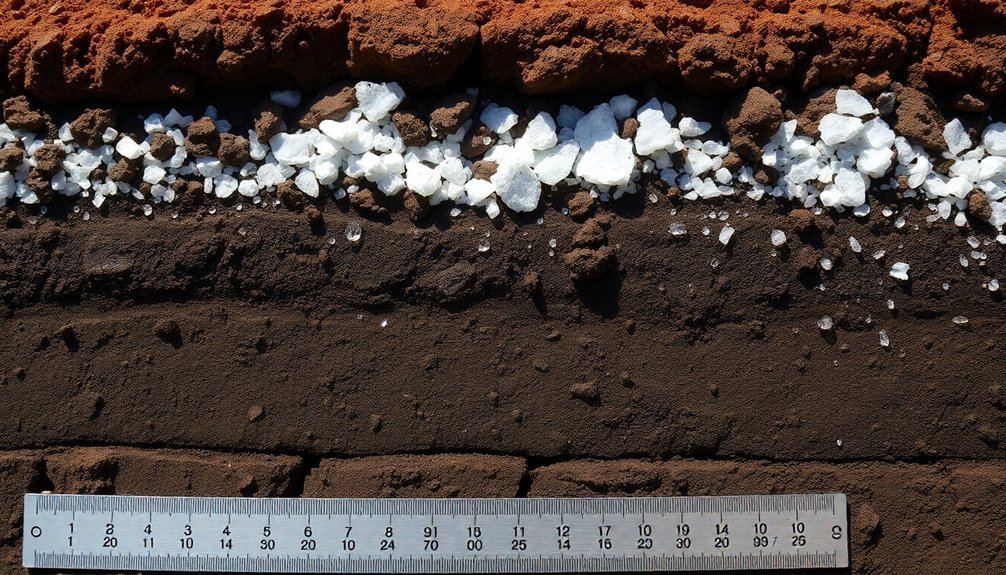
Over recent decades, engineers have discovered that adding salt to clay foundations drastically improves their structural integrity. When you combine salt with lime treatments, you'll notice significant enhancements in the soil's load-bearing capacity and overall strength.
This combination works through a process called flocculation, where clay particles are strongly attracted to each other, creating a more stable foundation.
You'll find that the ideal mixture typically includes 10% salt (NaCl) with 3% lime, which can substantially increase your foundation's ultimate strength. The stabilization process works through cation exchange, where metallic ions interact with calcium ions to transform the clay's engineering properties.
Here's what you can expect from salt-enhanced clay foundations:
- Improved shear strength and bearing capacity
- Enhanced stability through reduced expansion and contraction
- Better resistance to moisture-related problems
- Longer-lasting structural integrity with proper curing
When you're planning construction on clay soil, you'll need site-specific assessments to determine the right salt-lime mixture.
The foundation design must still account for clay's natural properties, but with salt enhancement, you'll achieve a more reliable and durable foundation system that can better support your structure.
Frequently Asked Questions
How Often Should Soil Additives Be Replaced in Earth Pit Storage?
You'll need to replace soil additives when you notice increased grounding resistance. Check regularly, but typically every 2-5 years, depending on your soil conditions and how well your current additives retain moisture.
Can Multiple Earth Pits Be Connected to Enhance Storage Capacity?
Yes, you can connect multiple earth pits to enhance capacity. When you interconnect them, you'll improve overall grounding efficiency and get better fault current distribution. It's a recommended practice for more reliable earthing systems.
What Is the Minimum Soil Depth Required for Effective Pit Storage?
You'll need at least 8 feet of soil depth for effective pit storage. While you can dig up to 20 feet deep, 8 feet is your minimum requirement to guarantee proper mechanical agitation and odor control.
Does Seasonal Temperature Variation Affect Earth Pit Storage Effectiveness?
Yes, seasonal temperature changes will affect your pit storage's effectiveness. You'll notice reduced efficiency during dry seasons when soil resistivity increases, while wet seasons improve performance due to better moisture retention.
How Can You Test Soil Conductivity Before Installing an Earth Pit?
You can test soil conductivity using handheld EC meters, laboratory analysis, test strips, or ERI methods. For best results, you'll want to use a calibrated EC meter directly in the soil or prepare samples.
In Summary
You'll find these seven soil types offer excellent options for your earth pit storage needs. Whether you're using clay-rich traditional soil or experimenting with salt-enhanced foundations, each mixture provides unique benefits for preservation. Consider your local climate and storage requirements when selecting the ideal soil composition. With proper preparation and maintenance, you'll create a reliable underground storage system that serves your preservation goals effectively.

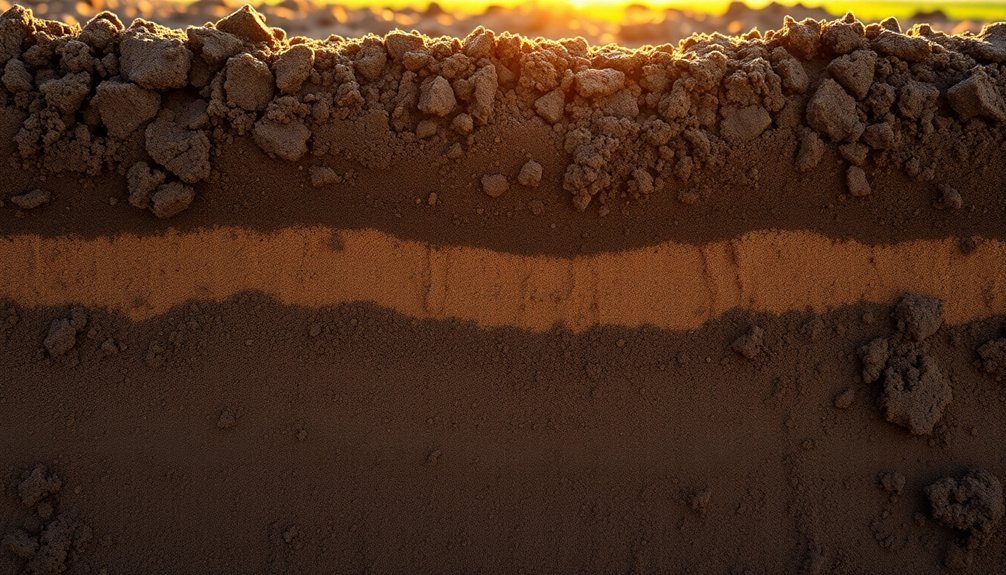



Leave a Reply